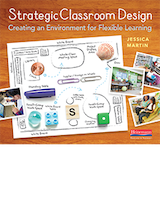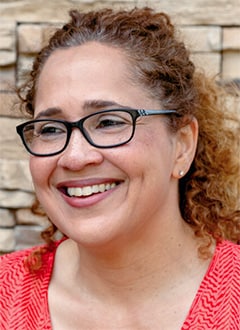Strategic Classroom Design: Creating an Environment for Flexible Learning

Imprint
Heinemann
Author(s):
Jessica Martin
Imagine each aspect of your classroom environment fine-tuned to meet the needs of your students. In Strategic Classroom Design, Jessica Martin explains how to get started.
This book explores how carefully designed classrooms lead to greater engagement and learning.
- Classroom setups that cultivate curiosity, belonging, and academic growth
- Design elements that make the greatest impact on teaching and learning
- Routines that help students move, transition, and interact in ways that maximize learning and minimize distraction
- Budget-friendly ideas for reorganizing your classroom
Photographs from a range of classroom environments are used to examine the different design choices teachers make. You’ll also find sample lessons detailing how to introduce your students to different areas in your classroom, a look at challenges many teachers face in a series of if/then questions throughout the book, and a photo-essay of one teacher’s journey with strategic classroom design.
Jessica reminds us, “The attention you give to the layout of your classroom provides everyone with a greater sense of belonging and more opportunities to become an engaged, focused, and collaborative community of learners.”
Authors

Jessica Martin
Jessica Martin (@growingjessica, @groweducators) is a former classroom teacher, a former resident advisor at UCLA’s Teacher Education Program Center X, and a former staff developer at Teachers College Reading and Writing Project, Columbia University. Jessica now leads a small consulting team that partners with K-12 schools in English Language Arts (ELA), Cognitively Guided Instruction (CGI) math, and inquiry-based content-area instruction. She is grateful for the opportunity to collaborate with educators and learning communities committed to co-creating incredible spaces, amplifying student voices, and implementing equitable learning opportunities for all learners. When she is not in schools, you can usually find her with her family on a basketball court shooting hoops.
More about Strategic Classroom Design
This book is designed for educators interested in learning more about the factors that contribute to well-designed classroom spaces that connect with students and help teachers more effectively navigate the world of teaching and learning. Each chapter is full of photographs of classrooms ranging from grades K to 8. I share predictable challenges, one or two transcribed sample lessons, a chart with specific lesson suggestions, and answers to some common questions in an "If–Then" section.
You can read this book from cover to cover or jump into a section that resonates with you; perhaps it connects to a challenge or opportunity in your classroom, everything from How can I create a learning space where everyone feels welcome and a sense of belonging? to What do I do about the daily traffic jam that occurs at the supply station? to How long should it take for my students to transition into the classroom from recess? We get used to constantly juggling what is in and out of our control. Sometimes we start off the school year without certain supplies, the arrival of new students with only a moment’s notice, and broken classroom furniture, but we make it work. I am confident that you’ll find the information, makeover stories, and photographs from educators—just like you—helpful and inspiring. You, too, have permission to be creative and resourceful in your practice, going beyond the surface-level work of simply creating aesthetically-pleasing learning spaces. Attention to classroom layout and co-authoring with students about each space’s rituals and routines will inspire a greater sense of belonging as well as provide students with opportunities to be part of an engaged, focused, and collaborative community of learners.
Table of Contents
Introduction: Jessica shows readers that just because you have 25 students in a classroom, doesn't mean you need 25 desks. Consider flexible seating your new best friend. Allow students to do their work where they are most comfortable. When students make their own decisions about where they learn best, engagement increases, potential behavioral issues reduce, and students are given autonomy over their learning. See this in action in the introduction where Jessica walks you through a day with Jayvon and allows his classroom experience to show rather than tell just how strategic classroom design works.
Chapter 1: What do we mean by classroom design? In this chapter we’ll explore the basic layout of your space from the ground up. We’ll consider how to make room for a whole-group space, small group spaces, individual work spaces, and your teacher space. When you are reimagining your classroom, it can feel overwhelming, so I’ll show you how to start with a simple layout plan.
Chapter 2: How can we set up our classrooms in strategic ways to cultivate curiosity, belonging, and academic growth? In this chapter, we’ll explore the other classroom work spaces—the library, multimedia learning space, maker space, play area, content area, and art space—and think about how they can be designed to help breathe life and inspiration into your learning journey with students.
Chapter 3: How can we help students move, transition, and interact with one another and the classroom environment in ways that feel conscious and connected? We’ll highlight the most commonly congested traffic areas and challenges. In addition, we’ll consider ways to help students transition with more intention and purpose and how to co-author plans with your students to efficiently gather supplies and complete assigned tasks and projects.
Chapter 4: Which elements of design make the most impact on teaching and learning according to research, and which are the most budget friendly? We’ll take a closer look at what the research says about the effects of light, color, sound, and natural elements on the classroom environment. Then we’ll explore practical ways to incorporate these design elements into your own classroom.
Chapter 5 Follow one teacher’s journey as she strategically designs her classroom space. See before-and after images and learn about the ups and downs she encounters along the way.
Virtual Samples
